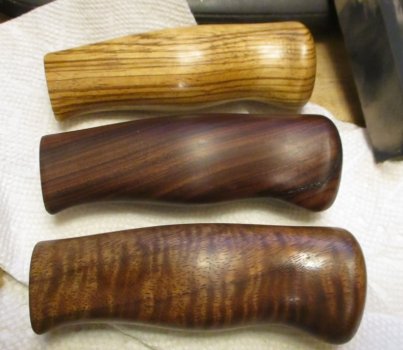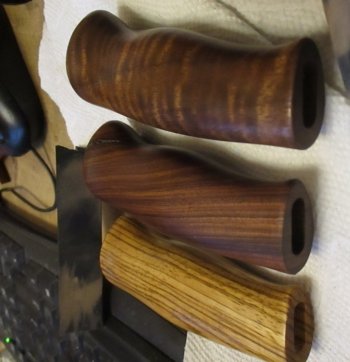Smallshop
KNIFE MAKER
Here's three Bowie handles I am working on...the top is Zebra Wood. chippy..."glows" but real straight grained...This will prolly be the only one. looks great on pool cues...knife handles? Meh...
middle is my new favorite wood. Pau Ferro...also known as "Bolivian Rosewood" (not a rose wood) and "Brazilian Ironwood" (a more correct term)
It is hard, dense, oily, and beautiful. no chatoyance but the color and tight grain make a muted finish especially beautiful. sealed it, waxed it...that's what you see. I will be making more knives with this one!This handle has a big check so I will put it on my hard-milled-bent-blade-pattern-machined experiment and keep it. i knew the check was there and wanted to see how it acted machining, filing, and sanding. I love this stuff!
bottom is Claro Walnut. works beautiful, unbelievable high-lights. Chocolate and orangish colors...super beautiful...I will be using this claro till Dad's gunstock wood runs out...which will be about 40 big handles if my guess is correct...(three blanks....)
Anyway thought y'all might enjoy some wood pics. (bottom pic is loading off rotation...sorry) View attachment 77398View attachment 77398
View attachment 77398View attachment 77398
middle is my new favorite wood. Pau Ferro...also known as "Bolivian Rosewood" (not a rose wood) and "Brazilian Ironwood" (a more correct term)
It is hard, dense, oily, and beautiful. no chatoyance but the color and tight grain make a muted finish especially beautiful. sealed it, waxed it...that's what you see. I will be making more knives with this one!This handle has a big check so I will put it on my hard-milled-bent-blade-pattern-machined experiment and keep it. i knew the check was there and wanted to see how it acted machining, filing, and sanding. I love this stuff!
bottom is Claro Walnut. works beautiful, unbelievable high-lights. Chocolate and orangish colors...super beautiful...I will be using this claro till Dad's gunstock wood runs out...which will be about 40 big handles if my guess is correct...(three blanks....)
Anyway thought y'all might enjoy some wood pics. (bottom pic is loading off rotation...sorry)
 View attachment 77398View attachment 77398
View attachment 77398View attachment 77398
